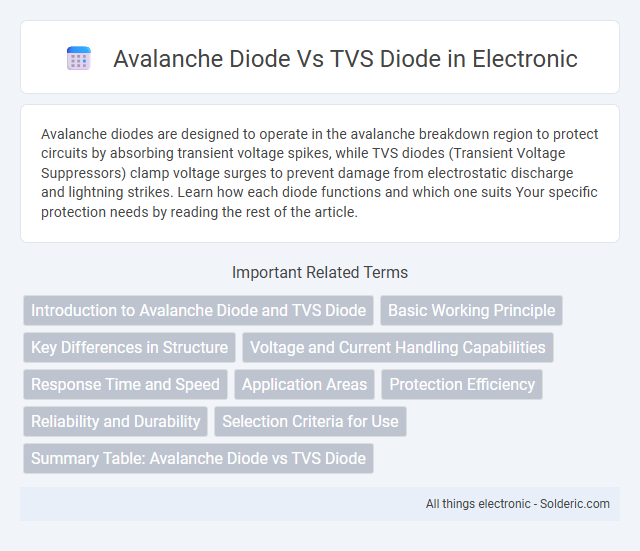Avalanche diodes are designed to operate in the avalanche breakdown region to protect circuits by absorbing transient voltage spikes, while TVS diodes (Transient Voltage Suppressors) clamp voltage surges to prevent damage from electrostatic discharge and lightning strikes. Learn how each diode functions and which one suits Your specific protection needs by reading the rest of the article.
Comparison Table
| Feature | Avalanche Diode | TVS Diode |
|---|---|---|
| Primary Function | Voltage clamping via avalanche breakdown | Transient voltage suppression for ESD and surge protection |
| Breakdown Mechanism | Avalanche breakdown at designed voltage | Clamps voltage during transient spikes |
| Response Time | Nanoseconds to microseconds | Picoseconds to nanoseconds (faster) |
| Typical Applications | Voltage regulation, surge limiting | ESD protection, transient surge suppression |
| Energy Absorption | Moderate | High energy transient absorption |
| Voltage Range | Wide range depending on device | Low to medium voltage transients |
| Design Focus | Precise avalanche voltage control | Fast response and high surge current capacity |
Introduction to Avalanche Diode and TVS Diode
Avalanche diodes are semiconductor devices designed to break down safely under high reverse voltage conditions, protecting circuits through controlled avalanche breakdown. TVS (Transient Voltage Suppressor) diodes rapidly clamp voltage spikes to shield sensitive electronics from transient overvoltages caused by lightning or switching surges. Understanding the differences between Avalanche and TVS diodes helps you select the right component to safeguard your circuit efficiently.
Basic Working Principle
Avalanche diodes operate by exploiting the avalanche breakdown phenomenon when a reverse voltage exceeds a specific threshold, allowing current to flow through the diode and protect circuits from voltage spikes. TVS (Transient Voltage Suppression) diodes function by clamping transient voltage surges through a fast response mechanism that limits voltage to safe levels, thereby safeguarding sensitive electronics. Both devices are designed for surge protection, but avalanche diodes primarily rely on controlled avalanche breakdown, whereas TVS diodes are engineered for rapid transient voltage suppression.
Key Differences in Structure
Avalanche diodes feature a thick, lightly doped p-n junction designed to sustain high reverse voltage and allow controlled avalanche breakdown without damage. TVS (Transient Voltage Suppression) diodes incorporate a heavily doped p-n junction to clamp transient voltage spikes rapidly and protect sensitive electronics. Structurally, the avalanche diode prioritizes stable avalanche multiplication, while the TVS diode emphasizes fast response and robust energy absorption capabilities.
Voltage and Current Handling Capabilities
Avalanche diodes excel in handling high-voltage spikes by operating beyond their breakdown voltage without damage, making them suitable for transient voltage suppression in circuits with voltages typically ranging from a few volts to several hundred volts. TVS (Transient Voltage Suppressor) diodes are designed to clamp voltage surges rapidly and can handle higher transient current pulses, often in the kiloampere range, providing robust protection for sensitive electronic components. Your choice depends on the specific voltage and current surge levels in your application, with Avalanche diodes favored for repetitive, controlled breakdown scenarios and TVS diodes preferred for absorbing large, instantaneous transient currents.
Response Time and Speed
Avalanche diodes exhibit a slightly slower response time compared to TVS (Transient Voltage Suppressor) diodes due to their avalanche breakdown mechanism, which requires a threshold voltage to be reached before conduction. TVS diodes respond almost instantaneously to voltage spikes, clamping transient voltages within nanoseconds to protect sensitive electronic components. Your choice depends on application speed requirements, with TVS diodes preferred for ultra-fast transient suppression.
Application Areas
Avalanche diodes are primarily used in voltage regulation and overvoltage protection in low-voltage circuits, signal clamping, and switching applications. TVS diodes are designed for transient voltage suppression and are widely applied in protecting sensitive electronic components from electrostatic discharge (ESD), lightning surges, and inductive load switching in automotive, telecommunications, and industrial equipment. Both components serve critical roles in safeguarding electronic systems but differ in response time and energy absorption capabilities tailored to specific transient voltage protection needs.
Protection Efficiency
Avalanche diodes offer fast response and controlled energy absorption, making them highly effective in protecting sensitive circuits from transient voltage spikes. TVS diodes excel at clamping voltage quickly with low clamping voltage levels, providing superior protection efficiency against large surges and electrostatic discharge (ESD). Choosing the right diode for your protection needs depends on the specific energy absorption capacity and response time required for your application.
Reliability and Durability
Avalanche diodes are designed to handle high-energy transient events with precise avalanche breakdown characteristics, offering consistent reliability under repetitive surge conditions. TVS diodes provide superior durability by clamping voltage spikes rapidly, ensuring protection against electrostatic discharge and voltage transients with minimal degradation over time. Your choice between avalanche and TVS diodes should consider the specific surge energy levels and frequency to achieve optimal long-term device performance.
Selection Criteria for Use
Avalanche diodes are selected for applications requiring precise breakdown voltage and controlled avalanche behavior in low-energy transient scenarios. TVS diodes are preferred for protecting sensitive electronics from high-energy voltage spikes due to their fast response and high energy absorption capabilities. Your choice depends on the specific voltage range, energy level, and response time needed for effective circuit protection.
Summary Table: Avalanche Diode vs TVS Diode
Avalanche diodes are designed to protect circuits by breaking down at a precise reverse voltage and safely dissipating energy during transient voltage spikes. TVS (Transient Voltage Suppressor) diodes provide rapid response clamping to transient voltage surges, safeguarding sensitive electronic components. Your selection depends on the application requirements: avalanche diodes suit controlled breakdown scenarios, while TVS diodes excel in high-energy transient suppression.
Avalanche diode vs TVS diode Infographic

 solderic.com
solderic.com